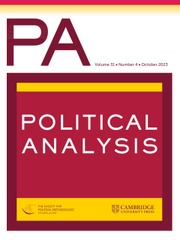Crossref Citations
This article has been cited by the following publications. This list is generated based on data provided by
Crossref.
Stanton, Christopher
and
Thomas, Catherine
2011.
Landing the First Job: The Value of Intermediaries in Online Hiring.
SSRN Electronic Journal,
2011.
Hainmueller, Jens
and
Xu, Yiqing
2011.
Ebalance: A Stata Package for Entropy Balancing.
SSRN Electronic Journal,
Fulmer, Sarah
and
Knill, April M.
2012.
Political Contributions and the Severity of Government Enforcement.
SSRN Electronic Journal,
Marcus, Jan
2012.
The Effect of Unemployment on the Mental Health of Spouses – Evidence from Plant Closures in Germany.
SSRN Electronic Journal,
Truex, Rory
2012.
Does China's National People's Congress Matter? The Returns to Office in a 'Rubber Stamp' Parliament.
SSRN Electronic Journal,
Heimer, Rawley
2012.
Leverage Constraints, Profitability, and Risk-Shifting: Evidence from the Introduction of Dodd-Frank.
SSRN Electronic Journal,
Hopkins, Daniel J.
and
Ladd, Jonathan McDonald
2012.
The Consequences of Broader Media Choice: Evidence from the Expansion of Fox News.
SSRN Electronic Journal,
Margolis, Michele
and
Sances, Michael
2012.
Who Really Gives? Partisanship and Charitable Giving in the United States.
SSRN Electronic Journal,
Bechtel, Michael M.
Hainmueller, Jens
and
Margalit, Yotam M.
2012.
Sharing the Pain: Explaining Public Opinion Towards International Financial Bailouts.
SSRN Electronic Journal,
Bonetti, Pietro
Cho, Charles H.
Michelon, Giovanna
and
Tanaka, Yuki
2013.
Environmental Disclosure and the Cost of Capital: Evidence from the Fukushima Nuclear Accident.
SSRN Electronic Journal,
Diamond, Alexis
and
Sekhon, Jasjeet S.
2013.
Genetic Matching for Estimating Causal Effects: A General Multivariate Matching Method for Achieving Balance in Observational Studies.
Review of Economics and Statistics,
Vol. 95,
Issue. 3,
p.
932.
Robinson, Rebecca L.
Kroenke, Kurt
Williams, David A.
Mease, Philip
Chen, Yi
Faries, Douglas
Peng, Xiaomei
Hann, Danette
Wohlreich, Madelaine
and
McCarberg, Bill
2013.
Longitudinal Observation of Treatment Patterns and Outcomes for Patients with Fibromyalgia: 12-Month Findings from the REFLECTIONS Study.
Pain Medicine,
Vol. 14,
Issue. 9,
p.
1400.
Nikolaev, Alexander G.
Jacobson, Sheldon H.
Cho, Wendy K. Tam
Sauppe, Jason J.
and
Sewell, Edward C.
2013.
Balance Optimization Subset Selection (BOSS): An Alternative Approach for Causal Inference with Observational Data.
Operations Research,
Vol. 61,
Issue. 2,
p.
398.
신인철
김병수
and
김영지
2013.
The effect of ability grouping on students' academic self-concept: Focusing on the mediating effect of social capital.
Korean journal of sociology of education,
Vol. 23,
Issue. 2,
p.
121.
Satyanath, Shanker
Voigtllnder, Nico
and
Voth, Hans-Joachim
2013.
Bowling for Fascism: Social Capital and the Rise of the Nazi Party in Weimar Germany, 1919-33.
SSRN Electronic Journal,
Choudhary, Preeti
Koester, Allison
and
Pawlewicz, Robert J.
2013.
Do Auditor-Provided Tax Services Impair Independence or Generate Knowledge Spillover? Evidence from Assessing Tax Accrual Quality.
SSRN Electronic Journal,
Ferwerda, Jeremy
and
Miller, Nicholas
2013.
Resistance to Foreign Rule: Evidence from a Natural Experiment.
SSRN Electronic Journal,
Richwine, Jason
2013.
How Much Time Do Teachers Spend Working? Evidence from the American Time Use Survey..
SSRN Electronic Journal,
Marcus, Jan
2013.
The effect of unemployment on the mental health of spouses – Evidence from plant closures in Germany.
Journal of Health Economics,
Vol. 32,
Issue. 3,
p.
546.

